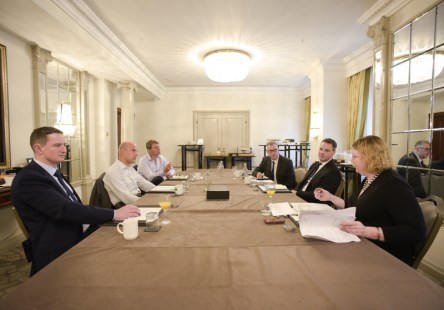Property Week and Yardi brought together a host of leading industry figures at The Office Group, The Shard In London to discuss what the property industry is doing to tackle the climate crisis. The panel: Neal Gemassmer, Vice president, international, Yardi Sam Carson, Director of sustainability innovation, Carbon Intelligence Janine Cole, Director of sustainability and community, Great Portland Estates Alex Green, Assistant director, British Property Federation Malcolm Hanna, Sustainability manager, real assets, LGIM Caroline Hill, Corporate affairs and sustainability director, Landsec David Partridge, Joint chief executive, Argent Related Steven Skinner, Chief executive, HB Reavis Liz Hamson, Editor, Property Week (chair) What is the industry doing to address the climate crisis? Has it woken up to the scale of the problem and started taking the right action, or is it still in the talking phase? Skinner: I ask the question in a slightly different way. Is the ambition the right ambition? Is the ambition big enough? I think we are slowly moving away from an accreditation-based approach to sustainability, but is that happening quickly enough? Is that going far enough? What key areas should the property industry focus on? Hill: I think you have to start from the fundamental facts and listen to the science. The built environment is responsible for nearly 40% of global carbon emissions and that is a fact. So we, as the property industry, have an enormous role to play in tackling climate change – it is drilling down into your particular business and looking at what can you do. At Landsec, our focus is on carbon reduction and energy reduction. Setting really bold and ambitious targets and making progress each year towards them. But each agent in the property industry – architects, designers, engineers, developers – have all got a different role to play. It is about finding your space and then going for it. Partridge: We have to constantly look at innovation and think how much can I do. So even back in the mid-2000s when we got planning permission for King’s Cross, we committed to being 20% better than building regulations. So we built in a central energy centre that provides heating, cooling and electricity. There is no boiler in any of the buildings – it is all provided centrally. Off the back of that we have been able to get BREEAM ‘outstanding’ ratings for every single one of our office buildings. Someone told me the other day that 10% of all the BREEAM ‘outstanding’ buildings [in the UK?] are at King’s Cross. I did not even know it because you sort of see it as part of what you do anyway. How big a problem is embodied carbon for the industry? Hill: When we started with our new sustainability strategy five years ago, one of the first things we did was a full carbon-footprinting exercise with the Carbon Trust looking at the whole range of activities that Landsec does. And what that told us is that our scope three is the absolute lion’s share of our footprint. So for us, that is how we build our buildings through our supply chain with our contractors, and then there is the energy-in-use of our occupiers. And so our programme has for years focused on embodied carbon because we know that is where our biggest footprint is. Hanna: The other thing to remember about embodied carbon is if you think about the operational carbon that will be emitted over the lifetime of the building, which could be anything from 10 to 50 years, the embodied carbon is right up front. In terms of our approach, L&G has had targets in place for quite a few years and we recently achieved our previous 10-year target. So we are in the process of updating our science-based targets for the next 10 years. What does the industry need to do to address the embodied carbon...
Amsterdam Think Tank
EU Rental Housing a Focus
AMSTERDAM – Terrence Wong (Yardi), Remco van de Wetering (Newomij), Hans Touw (Redevco), Robert-Jan Reeuwijk (CBRE) and Jaap van der Bijl (Altera) were recently invited to discuss the impact that social issues such as sustainability and affordability have on the value of residential property. According to Reeuwijk, the current housing market places even greater emphasis on the importance of an objective valuation of (properties) in a residential property portfolio. “When determining value, you use multiple sources so that you can look at standard parameters such as vacancy values or rental values. Then, using databases you can add new quality-defining elements such as the year of construction, the energy label and the location of the complex in question.” Transactions Van de Wetering states that the assessment of quality – and thus of value – has always been an issue in transactions, but he places even more emphasis on this fact for acquisitions. “More and more restrictions are being introduced at a local level for the mid-rental market segment and even then we don’t exactly know where the government wants to go in terms of regulation. But in determining the value of a portfolio, it is important to be aware of this both for the investors and the end users.” End user According to Touw, this depends on which definition you attribute to the term “end user.” “In my experience you are talking about the tenant. When determining quality, you start with the question of what the tenant’s experience is of this property, rather than just determining how good you think the product is for the tenant through the lens of the provider.” Measurable “What represents quality for one investor, does not for another,” asserts Van der Bijl. “As property investors, we want to measure, manage...
UK Think Tank
A Coworking Conversation
The evolution of the flexible office sector has shaken up the real estate industry and has arguably changed it for the better. Yardi recently brought together a panel of experts in the UK to discuss the many segments of flexible offices and what lies in store for the sector. Mary Finnigan, head of transactions, real estate, WeWork Chris Pieroni, operations director, Workspace Group Adrian Goldney, co-founder, Flexible Office Space John Williams, head of marketing, Instant Group Joff Sharpe, head of operations, British Land Tony Freeth, director coworking, Yardi Europe Liz Hamson, editor, Property Week – chair LH: With all the different definitions out there, what should we be calling the sector? Should there be a standard definition or does it really matter? CP: All the definitions out there are very different – hybrid, coworking, flexible, service – and then you’ve got all sorts of issues around whether they are an operator or a landlord and then you’ve got all sorts of issues about what sort of services are offered; whether they are exclusive or not. And it’s really complicated to pull all the data together and try to get an understanding. I’ve got my own view on where we stand in the flexible office market and we didn’t fit into any of the definitions. We’ve decided to just look at the flexible market. LH: So what do you define flexible as? CP: So we had three different categories – something under three months, and then we stopped at over 12 months. But actually, I think now as larger corporates want flexibility, you might be saying flexibility for them is three years. So I don’t know, but we stopped at over 12 months. JS: I don’t think the starting point is flexibility; it’s...
Tech + Logistics
Great Britain Automation Outlook
The rise of ecommerce has revolutionised the way we shop – but it has also transformed property logistics. Technology is helping retailers and carriers to manage stock movements, in-store click & collect and home deliveries, but it is also a costly investment. Who will pick up the tab? How are developers, investors, distributors and occupiers using ‘smart logistics’ to serve their customers? Yardi brought together a panel of thought leaders in a roundtable at Property Week’s Sheds Conference in Birmingham. The panel: Paul Crosbie, investment manager, M&G Real Estate Jonathan Gardner, head of asset management, Delin Capital Nick Kay, development director, St Modwen Properties Len Rosso, head of industrial and logistics, Colliers International Charles Spicer, Midlands industrial and logistics director, Savills Claer Barrett, personal finance editor, Financial Times (chair) CB: What do you all think the ‘shed of the future’ will look like? How will the needs of occupiers change over the next five years? LR: I don’t think we should call logistics space ‘sheds’ anymore. It is a much more technologically advanced product than the name suggests. Drones, robots and automation are all on the horizon, but I think the biggest change we’re seeing right now is higher eaves heights and mezzanine floors. Occupiers want to use all the space they’re paying for – not just the ground floor. PC: People are getting very excited about drone deliveries, but they are more likely to be used for rural areas rather than built-up urban locations where their use will be more restricted. JG: Occupiers will still be using vans and lorries, charge can bypass the 200-mile mark, it will really make a change to the use of this technology. NK: And look at the activity going on inside the shed. The rise of the ‘sharing economy’ is a big trend. We’ve seen Airbnb; now there’s a similar business called ZupplyChain for third- party logistics [3PL] companies with excess space to lease it out. If you can find space in areas of undersupply, it would make the market more fluid and ease the supply crunch. CS: The shed of the future won’t be one size fits all. Our market is very varied and diverse – so a manufacturer’s requirements are very different to that of a pure logistics operator. That said, we’re already seeing multi-level facilities and in the future we could well see subterranean ‘sheds’ in high-density urban areas. At the Property Week Sheds Conference, we’ve just heard a number of occupiers say they would not be averse to the idea of sharing space in the future so I anticipate more multi-user facilities as is commonplace in mainland Europe. There are covenant and lease issues but nothing that is insurmountable. We may see a company that is institutionally acceptable taking a ‘master lease’ and then space split between multiple users and companies in a Regus-type model. CB: As investors, how happy would you be with the idea of a shared shed? PC: A facility shared by a number of operators would be interesting if there was an overriding lease. It could give investors more comfort if there was some diversity alongside the main tenant. LR: DHL has been talking about that model for the past five years, but it hasn’t happened yet. JG: Well, it has happened in mainland Europe. 3PLs want to match their lease lengths with their contract terms. If they have a three-year contract, they don’t want to take a five-year lease. However, this comes at a cost – they accept they will have to pay a much higher rent in some locations. Other 3PLs will take a big lease and will stack the space with three or four different customers’ kit. Even then, there could be quite tough conditions to meet, such as 50% of the space being occupied by one client for the full length of the lease. PC: I agree that the sheds –...
British Mixed-Use
Yardi Real Estate Think Tank
Editor’s Note: As part of a recurring series in partnership with Property Week, Yardi hosts Think Tanks on real estate development trends in Great Britain. Recently, Yardi brought together a panel of experts to discuss future developments in mixed use, a concept that is gaining traction in the region. The Panelists: Victor Nicholls Assistant Chief Executive – Bracknell Forest Council Michael Auger Regional Director, South – Muse Developments Alistair Shaw Managing Director (TV Centre) – Stanhope Ben Giddens Executive Director – Development – Quintain Alan Harris Partner – Montagu Evans Claer Barrett Personal Finance Editor – Financial Times (chair) CB: Let’s begin by debating what have been the biggest changes to mixed-use over the past decade. BG: The biggest change was the last recession and what that meant for development sites. With the residential tap turned off, you had to look to other uses to bring schemes forward. MA: Mixed-use is the new normal. The biggest change has been the perceptions of funders and occupiers. Ten years ago, they might have felt a mixed-use scheme was ‘pushing the boundaries’ and it was hard work to convince funders in particular that a scheme was going to succeed. Now, they actually want to invest in mixed-use schemes – that’s a fundamental shift. VN: [There is more] enthusiasm from local authorities towards mixed-use, and much more flexibility. Yes, we like our zoning and masterplanning, but that comes from the pressure we’re under to deliver housebuilding targets. But I definitely see more flexibility in the public sector. BG: We have flexible planning consent on several plots of land at Wembley Park where we have outline consent from the local authority to develop offices, residential, hotel space or student accommodation above ground-floor retail. This allows us to respond...
UK Think Tanks
Emerging Market Insight
Yardi will host a series of think-tanks that unite industry professionals in discussion on the hottest issues facing real estate in the UK. This week: what are the prospects for property as an asset class? A new plan may draw investors from the capital to previously overlooked northern towns. During the global recession, emerging markets remained steady as developed markets faltered. Since the recovery, the major markets–US, Europe and Japan—have recaptured the attention of investors. But will London’s assets continue to lead England or are regional markets promising prospects? It could behoove investors to look beyond London’s city limits for growth opportunities. The capital’s highly competitive real estate market offers few new opportunities; the bulk of existing investors are vying for coveted space in the city’s 70-80 successful high street locations. It would be a shame for investors that do not make it into those locations to take their resources outside of the country. The solution: transform London’s regional markets into more attractive prospects. The Local Growth Fund has allocated £12bn to merge Leeds, Sheffield, Manchester, and Liverpool into the “northern powerhouse.” Supporters do not plan to siphon London’s businesses or big investors. Instead, the emphasis will be placed on nourishing successful local businesses and attracting new resources. Hopes ride on the dawn of new investors, those beat out of opportunities in London, for example, and those who are new to the arena, such as Chinese investors who have received more flexible access to foreign markets in recent years. As a rising business center, the northern powerhouse properties can be developed to fit modern tenants’ demands: Occupiers of the new business center will be greeted with competitive rents, convenient mixed-use facilities with eco-friendly features, and pedestrian friendly access. The northern powerhouse can be quite appealing in...






